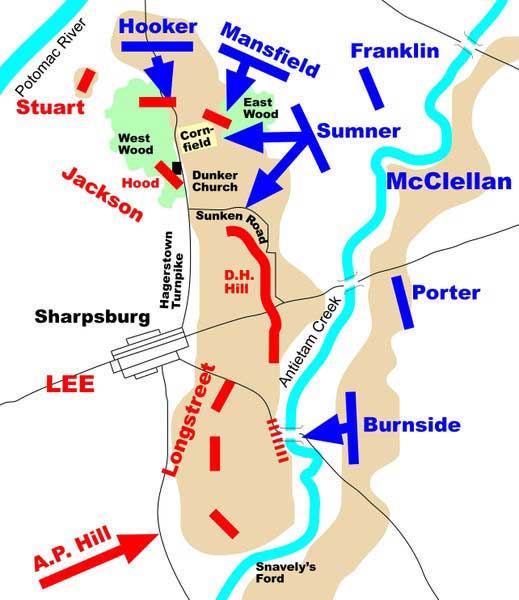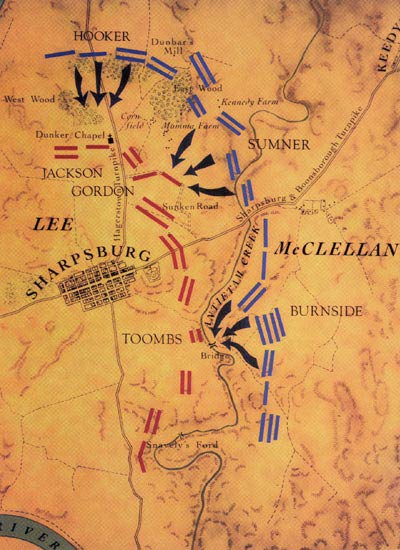Battlefield Map of Antietam during the American Civil War
(Click Photos to Enlarge)
Antietam Maps
The battle of Antietam was the bloodiest single day of the civil war, with over 23,000 casualties. The maps above show how Hooker and Mansfield attacked in the morning, Sumner came to their support but part of his corps turned southward, Burnside was slow in forcing a crossing and didn’t put troops on the other side of the creek until mid-afternoon.
The battle of Antietam was the bloodiest single day of the Civil War, with over 23,000 casualties. The Union commander, Major General George B. McClellan failed to fully develop a coordinated plan of attack with his corps commanders. As a result, the Battle of Antietam was fought in three, uncoordinated phases throughout the day on September 17, 1862. Without simultaneous pressure on all parts of his line McClellan’s opponent, Gen. Robert E. Lee, was able to shift troops wherever they were needed through most of the day, repeated stymieing the Federal assaults.
Battle of Antietam, Morning Phase
(The Cornfield, East Wood, West Wood, Dunker Church)
Late on the afternoon of September 16, Maj. Gen. Joseph Hooker crossed Antietam Creek with I Corps. As the map shows, the next morning he attacked Gen. Robert E. Lee’s left flank from the north along the Hagerstown Pike, shortly after dawn. A bloody fight ensued in The Cornfield (Miller’s Cornfield) and the West Wood.
Brigadier General Joseph Mansfield’s XII Corps, behind and to the left of Hooker, came to his support but arrived too late to coordinate with Hooker’s attack. The XII Corps pushed forward under Brig. Gen. Alpheus S. Williams after Mansfield fell mortally wounded. Fighting their way through the East Wood, they swept the remnants of Brig. Gen. John Bell Hood’s Texans from The Cornfield and penetrated the West Wood before Confederates of Lieutenant General Thomas "Stonewall" Jackson’s corps and Lt. Gen. J.E.B. "Jeb" Stuart’s dismounted cavalry halted their progress.
Two divisions of Major General Edwin Sumner’s II Corps crossed Antietam Creek sometime after 7:30 a.m., to support I and XII corps, already engaged. Major General John Sedgewick’s division followed part of XII Corps toward the West Wood and captured Dunker Church before Confederate counterattacks threw them back.
Battle of Antietam, Second Phase
(The Sunken Road)
Sumner’s other division, that of Brig. Gen. William H. French, swung left toward the center of the Confederate line. French’s men encountered Confederates of Maj. Gen. Daniel Harvey Hill’s division occupying a strong defensive position in a sunken farm road. In the fighting that ensued the road turned muddy from the blood pouring into it. The Sunken Road is also called Bloody Lane. The Federals were reinforced by Brig. Gen. Thomas Francis Meagher’s Irish Brigade. Brigadier General Ambrose Wright’s brigade of Maj. Gen. Richard H. "Fighting Dick" Anderson’s division reinforced Hill’s Confederates, Eventually, the Union troops captured the position but were too spent to push into Sharpsburg and cut Lee’s line in two.
Battle of Antietam, Third Phase
(Burnside Bridge)
On the south end of the field, Maj. Gen. Ambrose Burnside was supposed to cross the creek as soon as the Union attacks farther to the right showed signs of progress. Faced with crossing the 12-foot-wide Rohrbach Bridge, he used only a portion of his IX Corps to press the attack against three Confederate batteries and Brig. Gen. Robert Toombs 600-man infantry brigade of Lt. Gen. James Longstreet’s Corps. Positioned on a steep hill on the west side of Antietam Creek. Toombs’ small force kept Burnside’s men east of Antietam Creek until the bridge was captured around 1:00 p.m. Two hours later, Burnside’s corps completed their crossing. The Rohrback Bridge became known afterward as Burnside’s Bridge.
For hours, Confederate major general A. P. Hill had been driving his Light Division up the road from Harpers Ferry to rejoin Lee’s army. They arrived late in the afternoon, just as Burnside was advancing toward Sharpsburg. Hill’s tired troops immediately went into line of battle and attacked Burnside’s left flank, ending McClellan’s best chance of the day to capture the town and cut off Lee’s escape. As night fell, America’s bloodiest day came to a close.
Throughout the battle, McClellan kept Maj. Gen. Fitz-John Porter’s V Corps, plus a division of the VI Corps, in reserve, never committing them to combat.


